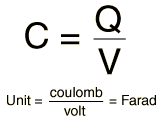Charge on Series Capacitors
 |
Since charge cannot be added or taken away from the conductor between series capacitors, the net charge there remains zero. As can be seen from the diagram, that constrains the charge on the two capacitors to be the same in a DC situation. This charge Q is the charge you get by calculating the equivalent capacitance of the series combination and multiplying it by the applied voltage V.
You store less charge on series capacitors than you would on either one of them alone with the same voltage!
|
Does it ever make sense to put capacitors in series? You get less capacitance and less charge storage than with either alone. It is sometimes done in electronics practice because capacitors have maximum working voltages, and with two "600 volt maximum" capacitors in series, you can increase the working voltage to 1200 volts.
|
Index
Capacitance concepts
Inductance concepts |


